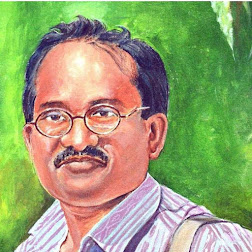handlooms
12:28 PM
What is IKAT
Ikat means the “tie and dye” technique of weaving which has been invented by the mankind since time immemorial. The word “ikat” likely to be originated from the Indonesian language “mangikat” which literally means tying a bunch of yarn to dye, before its weaving. This method of weaving is popularly known as “Bandha” in Odisha where as it is called “Bandhni” in Gujrat.
The procedure to weave a length of any cloth is to firmly interlace the yarn horizontally and vertically. On the other hand in the ikat weaving the yarn is tinted at the needed places prior to it’s weaving. The yarn when loaded vertically into the handloom machine it is called warp (tani), while the horizontal yarn which shuttles in between the warp is called the weft (buna). The warp is the tightly stretched length wise core of the fabric which tends to be stronger and coarser, while the weft is woven between the warp threads to bring various patterns on the textile. Mostly the resist dyeing is done on the weft yarn which is loaded in a shuttle. But even a more complex work is done by double-ikat, where both the warp and the weft undergo the resist dyeing. The double-ikat fabric got the same design at both sides of the cloth. This unique feature could never be possible on any cloth manufactured in a power loom, despite the fact so much advances made in the technology ever since the industrial revolution a century back.
The procedure to weave a length of any cloth is to firmly interlace the yarn horizontally and vertically. On the other hand in the ikat weaving the yarn is tinted at the needed places prior to it’s weaving. The yarn when loaded vertically into the handloom machine it is called warp (tani), while the horizontal yarn which shuttles in between the warp is called the weft (buna). The warp is the tightly stretched length wise core of the fabric which tends to be stronger and coarser, while the weft is woven between the warp threads to bring various patterns on the textile. Mostly the resist dyeing is done on the weft yarn which is loaded in a shuttle. But even a more complex work is done by double-ikat, where both the warp and the weft undergo the resist dyeing. The double-ikat fabric got the same design at both sides of the cloth. This unique feature could never be possible on any cloth manufactured in a power loom, despite the fact so much advances made in the technology ever since the industrial revolution a century back.
To produce an ikat saree entire family members are engaged for a week to four week time depending upon the intricacy of the design. So you could assess how labour intensive is this industry which in fact provides livelihood to thousands of families nationwide.
Before the weaving the yarn is pre-fabricated with colour by resist dyeing technique. As per the design the bunch of yarn is tightly tied with the cotton threads at the needed places and then drenched in colour. The confiscated area of the yarn retains the original colour (white) while the remaining portion of the yarn absorbs the colour in which it has been soaked. When the yarn is dried, the knots are opened with hands and then it goes through a series of hand operated tools like asari, upharna, badhikatar, punraa, kamancha, kamda, rahata(called charkha in Hindi), phani, nari(shuttle), nalli (bobbin) before entering monga. Monga is otherwise popularly known as khatkhati for the echo “khat khat” which is generated from the wood while the handloom machine is operated.
Related posts :
Padmashree Chaturbhuja Meher - Drapping the Nation with his ikat fabrics
Ikat Tour of Barpali by a French Lady
Padmashree Chaturbhuja Meher - Drapping the Nation with his ikat fabrics
Ikat Tour of Barpali by a French Lady
Cell # +918249314972
E.Kiran Mohan(The Writer)
C/o.Dr.E.R.Rao (MD)
Tehsil Chowk,
At\PO : BARPALI – 768029
Dist.Bargarh, Odisha, India









![EKUSIA [ଏକୁସିଆ]](http://2.bp.blogspot.com/-IVkk6zhpWdY/UDDbYrQcj3I/AAAAAAAABP8/d0814kzOx4Q/w72-h72-p-k-no-nu/Ekusia.jpg)

